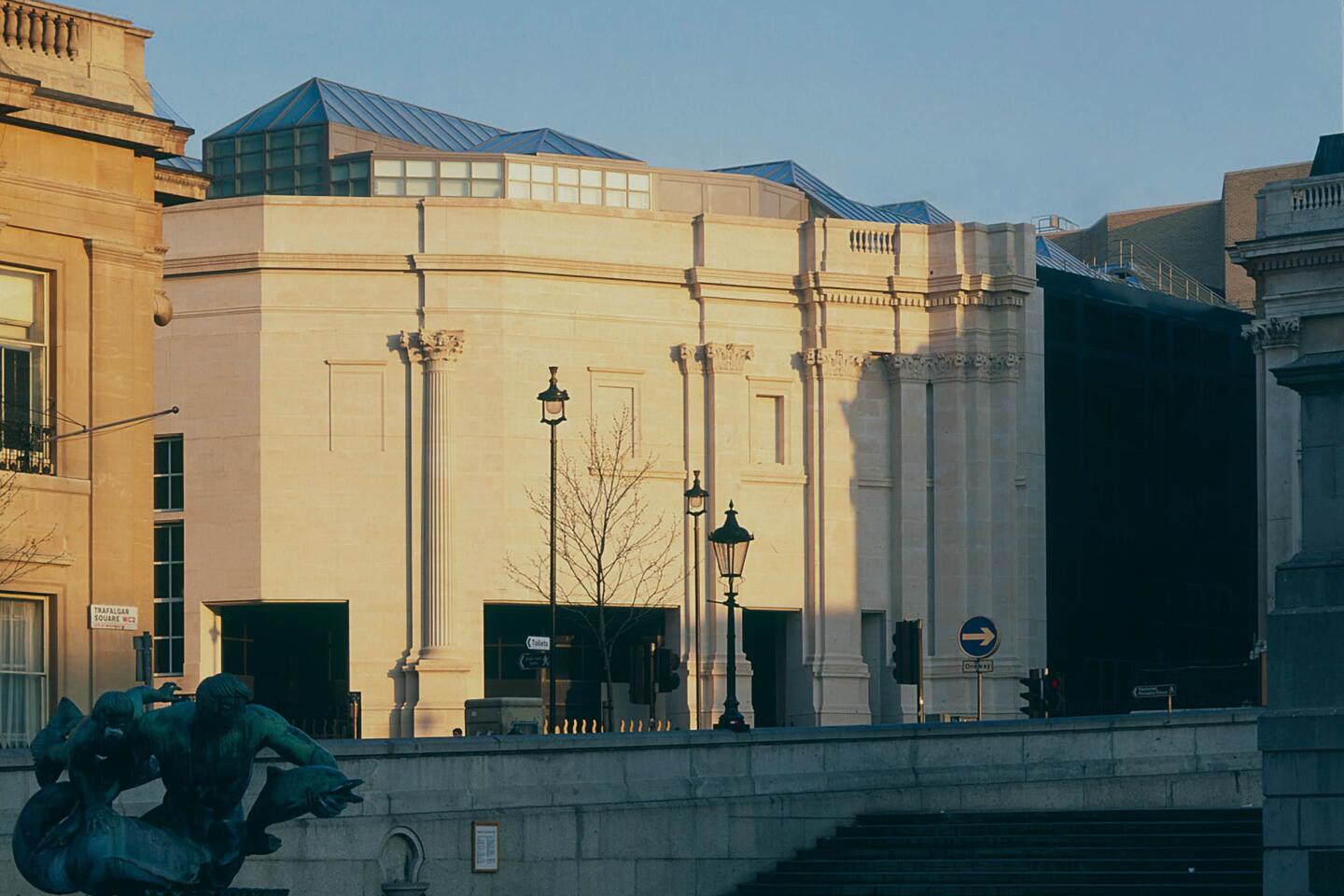The National Gallery is comprised of two sites – the Wilkins Building, which stands on the northern side of Trafalgar Square, and the Sainsbury Wing to the west. The buildings, both Grade I listed, are connected by a circular link building set on Jubilee Walk.
Site

The Sainsbury Wing
The Wilkins Building, the Gallery’s main building, is known for its gravitas, its distinctive grey cupola and Corinthian porticoes. The result of an architectural competition won by William Wilkins, the building was completed in 1838 and is in a classical Graeco-Roman style. The dominant building on Trafalgar Square, it provides mass and contrast to Nelson’s Column and the Fourth Plinth, the latter hosting a changing programme of contemporary artworks. Once described by a nineteenth-century Justice as ‘the very gangway of London’, Trafalgar Square in recent years has become a place of shifting identities and moods, of celebration and political protests and rallies, as well as a venue for Christmas markets, and street performance.
The Post-Modern Sainsbury Wing opened by Her Majesty The Queen in 1991 was the last major addition to the Gallery’s estate. This intervention, a Palazzo-like addition by American architects Robert Venturi and Denise Scott Brown (VSBA), was a pragmatic and healing solution following an earlier design competition which proposed a controversial commercial tower – vividly described at the time by HRH The Prince of Wales as a ‘monstrous carbuncle’.
Originally, the building was intended to provide extra gallery space, while being only an overflow entrance to the Gallery, a junior partner to the historic Portico Entrance in the Wilkins Building.
However, since 2018, for security, accessibility and logistical reasons, most of the Gallery’s six million annual guests have been directed to enter through the Sainsbury Wing, which has become the main entrance. From a curatorial perspective, this has underpinned a deeper logic – the galleries on the building’s top floor initiate a visitor journey through the collection that is broadly chronological.
In terms of architectural thinking, the Sainsbury Wing makes formal reference to a traditional Palazzo.
The original design concept envisaged the foyer as being like a crypt, where the mass of Portland Stone linings creates a visual contrast with the side light from the grand staircase.
The organisational parti (design concept) is driven by the grand staircase, which, with its own prescribed volume, deploys mannered perspectival space to magnify the visitors’ sense of procession as they rise up two levels from the ground to the second floor galleries.
The top floor, comprising an enfilade of 16 gallery spaces, is the predominant floor, reminiscent of a piano nobile. Here, the floor level and the circulation axis are both integrated with the original Wilkins Building to establish continuity of circulation through all gallery spaces.
Not only are these elements understood as being set pieces that express the character of VSBA’s architecture, together they are essential to the legibility of the original design concept. Of less significance are the first floor and the below ground levels. The first floor is accessed off the grand stair’s half landing and is currently the location of the restaurant and conference rooms.
The two basement levels are served by a return leg of the main staircase, providing access to the Auditorium’s ante space at upper basement level, and the Temporary Exhibition Gallery on the lower level.
The Sainsbury Wing has more than met its original brief – especially in the provision of its 16 world-class upper galleries and despite being intended to accommodate just three million visitors – pre-pandemic it has been coping with six million.
The Sainsbury Wing’s configuration inevitably reflects the Gallery’s needs of 30 years ago. Excepting the upper galleries, the Auditorium and the Temporary Exhibition Gallery, all of which will be untouched, the building’s entrance and support spaces identified by this project, now need a thorough rethink.
The scope of the NG200 Project also includes consideration of the National Gallery’s public realm, including scope to reimagine the Gallery’s interface with its immediate context, including the Sainsbury Wing’s loggia in the west, Jubilee Walk, the front of the Wilkins Building’s main façade and the Gallery’s eastern end at St Martin’s Place.
For more details on the Sainsbury Wing and the National Gallery’s wider site, please consult the Design Brief.